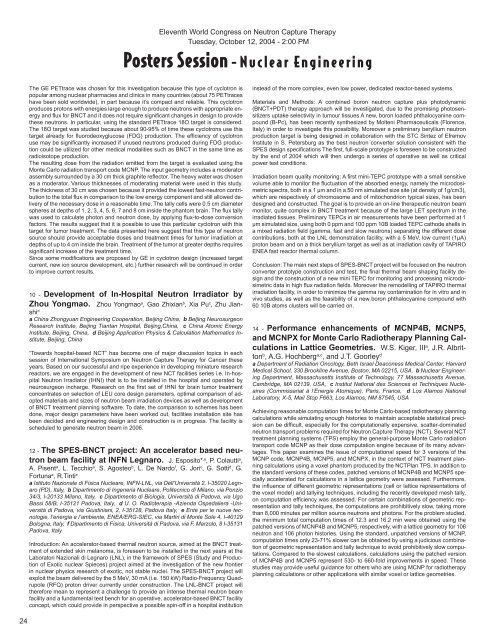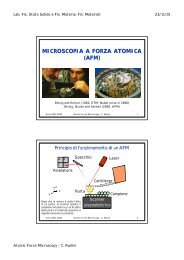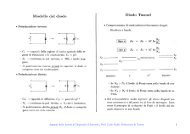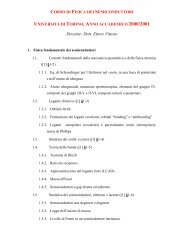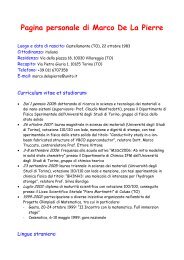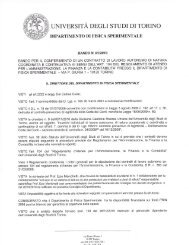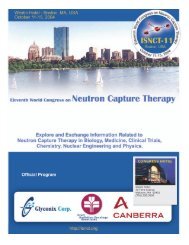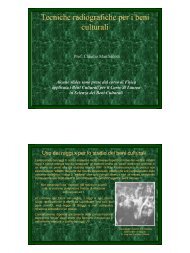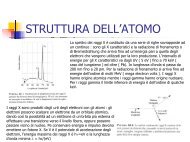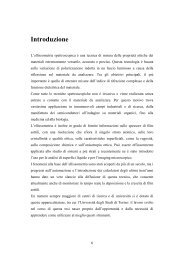You also want an ePaper? Increase the reach of your titles
YUMPU automatically turns print PDFs into web optimized ePapers that Google loves.
Eleventh World Congress on Neutron Capture TherapyTuesday, October 12, 2004 - 2:00 PMPosters Session - N u c l ea r E n g i n e e r i n gThe GE PETtrace was chosen for this investigation because this type of cyclotron ispopular among nuclear pharmacies and clinics in many countries (about 75 PETtraceshave been sold worldwide), in part because it’s compact and reliable. This cyclotronproduces protons with energies large enough to produce neutrons with appropriate energyand flux for BNCT and it does not require significant changes in design to providethese neutrons. In particular, using the standard PETtrace 18O target is considered.The 18O target was studied because about 90-95% of time these cyclotrons use thistarget already for fluorodeoxyglucose (FDG) production. The efficiency of cyclotronuse may be significantly increased if unused neutrons produced during FDG productioncould be utilized for other medical modalities such as BNCT in the same time asradioisotope production.The resulting dose from the radiation emitted from the target is evaluated using theMonte Carlo radiation transport code MCNP. The input geometry includes a moderatorassembly surrounded by a 30 cm thick graphite reflector. The heavy water was chosenas a moderator. Various thicknesses of moderating material were used in this study.The thickness of 30 cm was chosen because it provided the lowest fast-neutron contributionto the total flux in comparison to the low energy component and still allowed deliveryof the necessary dose in a reasonable time. The tally cells were 0.5 cm diameterspheres at depths of 1, 2, 3, 4, 5, 6, 7 and 8 cm inside the phantom brain. The flux tallywas used to calculate photon and neutron dose, by applying flux-to-dose conversionfactors. The results suggest that it is possible to use this particular cyclotron with thistarget for tumor treatment. The data presented here suggest that this type of neutronsource should provide acceptable doses and treatment times for tumor irradiation atdepths of up to 4 cm inside the brain. Treatment of the tumor at greater depths requiressignificant increase of the treatment time.Since some modifications are proposed by GE in cyclotron design (increased targetcurrent, new ion source development, etc.) further research will be continued in orderto improve current results.10 - Development of In-Hospital Neutron Irradiator byZhou Yongmao. Zhou Yongmao a , Gao Zhixian b , Xia Pu c , Zhu Jianshida China Zhongyuan Engineering Cooperation, Beijing China, b Beijing NeurosurgeonResearch Institute, Beijing Tiantan Hospital, Beijing,China, c China Atomic EnergyInstitute, Beijing, China, d Beijing Application Physics & Calculation Mathematics Institute,Beijing, China“Towards hospital-based NCT” has become one of major discussion topics in eachsession of International Symposium on Neutron Capture Therapy for Cancer theseyears. Based on our successful and ripe experience in developing miniature researchreactors, we are engaged in the development of new NCT facilities series i.e. In-hospitalNeutron Irradiator (IHNI) that is to be installed in the hospital and operated byneurosurgeon incharge. Research on the first set of IHNI for brain tumor treatmentconcentrates on selection of LEU core design parameters, optimal comparison of adoptedmaterials and sizes of neutron beam irradiation devices as well as developmentof BNCT treatment planning software. To date, the comparison to schemes has beendone, major design parameters have been worked out, facilities installation site hasbeen decided and engineering design and construction is in progress. The facility isscheduled to generate neutron beam in 2006.12 - The SPES-BNCT project: An accelerator based neutronbeam facility at INFN Legnaro. J. Esposito* ,a , P. Colautti a ,A. Pisent a , L. Tecchio a , S. Agosteo b , L. De Nardo f , G. Jori c , G. Sotti d , G.Fortuna a , R.Tinti ea Istituto Nazionale di Fisica Nucleare, INFN-LNL, via Dell’Università 2, I-35020 Legnaro(PD), Italy, b Dipartimento di Ingeneria Nucleare, Politecnico di Milano, via Ponzio34/3, I-20133 Milano, Italy, c Dipartimento di Biologia, Università di Padova, via UgoBassi 58/B, I-35121 Padova, Italy, d U. O. Radioterapia -Azienda Ospedaliera -Universitàdi Padova, via Giustiniani, 2, I-35128, Padova Italy, e Ente per le nuove tecnologie,l’energia e l’ambiente, ENEA/ERG-SIEC, via Martiri di Monte Sole 4, I-40129Bologna, Italy, f Dipartimento di Fisica, Università di Padova, via F. Marzolo, 8 I-35131Padova, ItalyIntroduction: An accelerator-based thermal neutron source, aimed at the BNCT treatmentof extended skin melanoma, is foreseen to be installed in the next years at theLaboratori Nazionali di Legnaro (LNL), in the framework of SPES (Study and Productionof Exotic nuclear Spieces) project aimed at the investigation of the new frontierin nuclear physics research of exotic, not stable nuclei. The SPES-BNCT project willexploit the beam delivered by the 5 MeV, 30 mA (i.e. 150 kW) Radio-Frequency Quadrupole(RFQ) proton driver currently under construction. The LNL-BNCT project willtherefore mean to represent a challenge to provide an intense thermal neutron beamfacility and a fundamental test bench for an operative, accelerator-based BNCT facilityconcept, which could provide in perspective a possible spin-off in a hospital institutioninstead of the more complex, even low power, dedicated reactor-based systems.Materials and Methods: A combined boron neutron capture plus photodynamic(BNCT+PDT) therapy approach will be investigated, due to the promising photosensitizersuptake selectivity in tumour tissues A new, boron loaded phthalocyanine compound(B-Pc), has been recently synthesized by Molteni Pharmaceuticals (Florence,Italy) in order to investigate this possibility. Moreover a preliminary beryllium neutronproduction target is being designed in collaboration with the STC Sintez of EfremovInstitute in S. Petersburg as the best neutron converter solution consistent with theSPES design specifications The first, full-scale prototype is foreseen to be constructedby the end of 2004 which will then undergo a series of operative as well as criticalpower test conditions.Irradiation beam quality monitoring: A first mini-TEPC prototype with a small sensitivevolume able to monitor the fluctuation of the absorbed energy, namely the microdosimetricspectra, both in a 1 µm and in a 50 nm simulated size site (at density of 1g/cm3),which are respectively of chromosome and of mitochondrion typical sizes, has beendesigned and constructed. The goal is to provide an on-line therapeutic neutron beammonitor, quite complex in BNCT treatment because of the large LET spectrum in theirradiated tissues. Preliminary TEPCs in air measurements have been performed at 1µm simulated size, using both 0 ppm and 100 ppm 10B loaded TEPC cathode shells ina mixed radiation field (gamma, fast and slow neutrons) separating the different dosecontributions, both at the LNL demonstration facility, with a 5 MeV, low current (1µA)proton beam and on a thick beryllium target as well as at irradiation cavity of TAPIROENEA fast reactor thermal column.Conclusion: The main next steps of SPES-BNCT project will be focused on the neutronconverter prototype construction and test, the final thermal beam shaping facility designand the construction of a new mini TEPC for monitoring and processing microdosimetricdata in high flux radiation fields. Moreover the remodelling of TAPIRO thermalirradiation facility, in order to minimize the gamma ray contamination for in vitro and invivo studies, as well as the feasibility of a new boron phthalocyanine compound with60 10B atoms clusters will be carried on.14 - Performance enhancements of MCNP4B, MCNP5,and MCNPX for Monte Carlo Radiotherapy Planning Calculationsin Lattice Geometries. W.S. Kiger, III a , J.R. Albrittonb , A.G. Hochberg a,c , and J.T. Goorley da Department of Radiation Oncology, Beth Israel Deaconess Medical Center, HarvardMedical School, 330 Brookline Avenue, Boston, MA 02215, USA, b Nuclear EngineeringDepartment, Massachusetts Institute of Technology, 77 Massachusetts Avenue,Cambridge, MA 02139, USA, c Institut National des Sciences et Techniques Nucléaires(Commissariat à l’Energie Atomique), Paris, France, d Los Alamos NationalLaboratory, X-5, Mail Stop F663, Los Alamos, NM 87545, USAAchieving reasonable computation times for Monte Carlo-based radiotherapy planningcalculations while simulating enough histories to maintain acceptable statistical precisioncan be difficult, especially for the computationally expensive, scatter-dominatedneutron transport problems required for Neutron Capture Therapy (NCT). Several NCTtreatment planning systems (TPS) employ the general-purpose Monte Carlo radiationtransport code MCNP as their dose computation engine because of its many advantages.This paper examines the issue of computational speed for 3 versions of theMCNP code, MCNP4B, MCNP5, and MCNPX, in the context of NCT treatment planningcalculations using a voxel phantom produced by the NCTPlan TPS. In addition tothe standard versions of these codes, patched versions of MCNP4B and MCNP5 speciallyaccelerated for calculations in a lattice geometry were assessed. Furthermore,the influence of different geometric representations (cell or lattice representations ofthe voxel model) and tallying techniques, including the recently developed mesh tally,on computation efficiency was assessed. For certain combinations of geometric representationand tally techniques, the computations are prohibitively slow, taking morethan 8,000 minutes per million source neutrons and photons. For the problem studied,the minimum total computation times of 12.3 and 16.2 min were obtained using thepatched versions of MCNP4B and MCNP5, respectively, with a lattice geometry for 106neutron and 106 photon histories. Using the standard, unpatched versions of MCNP,computation times only 23-71% slower can be obtained by using a judicious combinationof geometric representation and tally technique to avoid prohibitively slow computations.Compared to the slowest calculations, calculations using the patched versionof MCNP4B and MCNP5 represent 530- to 660-fold improvements in speed. Thesestudies may provide useful guidance for others who are using MCNP for radiotherapyplanning calculations or other applications with similar voxel or lattice geometries.24


